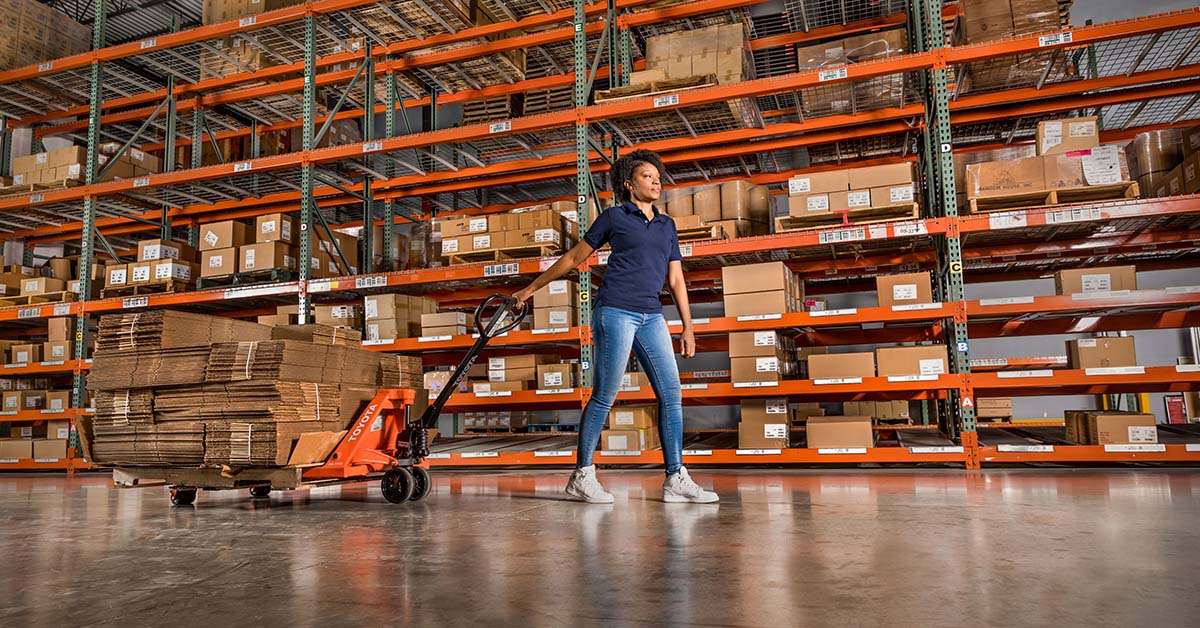Are you in the market for a pallet jack? There are many factors to consider when purchasing pallet trucks, especially if your primary use is in a warehouse.
Obviously, the basic purpose of a pallet jack is to transport pallets around a warehouse, industrial operation or some other operation where pallets have to be moved.
However, when considering the size of your facility, the gross weight of pallets being positioned, the frequency of use, and many other variables, you may want to educate yourself on which pallet jacks perform best in which environments.
The following feature is a review of pallet truck styles, qualities, limits and types of uses.
Manual Pallet Jacks
Non-motorized pallet jacks have been in use since around 1920 and have not changed a whole lot since that era. They consist of a steel body, a fork and a hydraulic pump that’s actuated by pumping the handle in an up and down motion.
The operator of a hand pallet truck positions the forks underneath the pallet, manually raises the pallet above the floor via the hydraulic system and wheels the pallet to a desired spot, maneuvering the pallet jack with the tiller.
Scenarios where only a few inches of lift height is necessary may be a good application for a non-powered pallet truck, including storage room aisles, warehouse short runs and similar types of applications. Unlike a forklift, pallet jacks are also moderately mobile and will fit in the back of a van or truck for delivering products. The load capacity of many non-motorized pallet jacks is about 5500 lbs.
Manual pallet jacks are best suited for intermittent use conditions over short ranges. Hand pallet jacks are not the best selection for moving loads over extended distances, inclines or rough floor or lot surfaces. Workers need to physically push or pull the equipment which can quickly become physically taxing.
Walkie Pallet Jacks
Although approximately two times the overall size of manual pallet jacks, walkies are still reasonably small in scale and they are exceptionally maneuverable.
Walkie pallet jacks are propelled by on-board batteries. The battery generates a powered assist for operating and elevating the forks. The operators no longer needs to activate the handle to elevate the pallet, nor do they have to manually maneuver the pallet along through the warehouse.
However, they are still called “walkies”, given that the operator does still have to walk to the rear or the side of the truck.
A walkie pallet truck’s highest speed is lower as compared to rider jacks, given that the driver must keep up with the jack rather than catching a ride on it. This is in fact a bit of an unintentional “safety feature”, since restricted speeds also limit the impact of collisions.
The maximum capacity of the majority of walkie pallet jacks is between 4500-6000 lbs.
Despite the fact that they’re more convenient than manual pallet jacks, walkies need to be recharged regularly, given that they are battery operated. They also call for more maintenance than manual pallet jacks because there are more moving parts and points of potential electrical issues.
The primary uses for walkie pallet jacks are loading docks, staging areas and brief to mid-distance runs.
Rider Pallet Jacks
Rider jacks function like walkies, although they feature a standing platform for the driver. There are very few controls on rider trucks so they are fairly straightforward to maneuver and call for comparatively little training.
Drivers can climb on the platform instead of just walking beside or behind the pallet truck. This means that rider trucks are a better option for moving loads over longer distances versus hand or walkie pallet jacks. They’re perfect for constant movement over greater distances and they are used quite often in large warehouses and manufacturing enterprises.
The operator platform is well-suited for quick trips, but not recommended for drivers that make use of them day-in and day-out because they are rather small and cause the operator to stand in an unnatural position.
Rider jacks are heavier than walkie or manual pallet jacks, so accidents can result in fairly significant injury and property damage. Rider pallet jacks also offer minimal defense for the operator vs other choices like center riders.
Center Riders
Center rider jacks resemble rider pallet jacks, but they offer more protection for the operator and provide a more ergonomic experience. The driver can stand completely to the back or to the front as opposed to solely sideways.
There is also minimal hazard for the driver, considering they are insulated by the equipment frame on two sides, although they are still exposed to the potential danger of the lifting mechanism.
Center riders are less maneuverable than rider pallet jacks and they are frequently employed for uses where the operator proceeds mostly in a direct path.
Center riders are quite often employed in general manufacturing, storage facilities and beverage uses.
Pallet Jacks Near Me
If you’d like to get a better understanding of pallet jack options for your Utah warehouse, DC or manufacturing facility, talk to a material handling expert at Welch Equipment by calling (801) 972-9272.
Welch Equipment Company
2181 South 3200 West
Salt Lake City, UT 84119
(801) 972-9272
Serving Alta, Bluffdale, Cottonwood Heights, Draper, Grantsville, Herriman, Holladay, Midvale, Millcreek, Murray, Ophir, Riverton, Rush Valley, Salt Lake City, Sandy, South Jordan, South Salt Lake, Stockton, Taylorsville, Tooele, Vernon, Wendover, West Jordan, West Valley City



